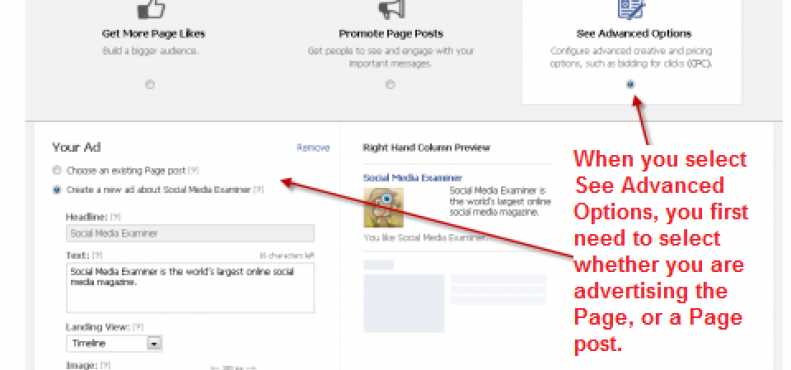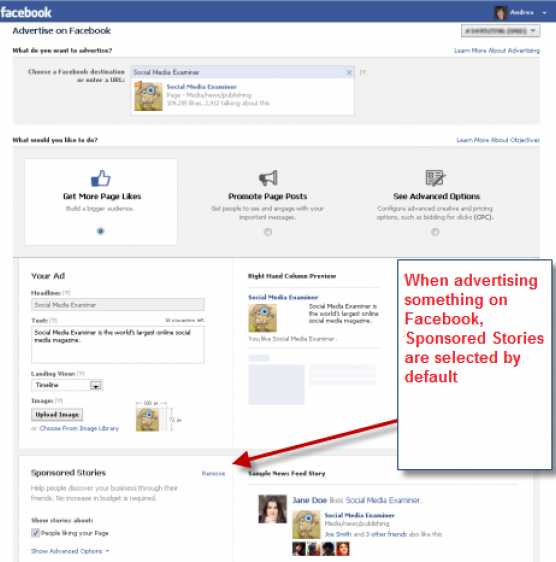Are you interested in getting more bang for your buck when it comes to advertising?
This article will show you four ways to enhance your Facebook Ads.
What Changed Within Facebook Ads?
If you’ve been running Facebook Ads over the past year, you may be confused by some of the newer options and the new layout of the Ads area. You may have felt like you had a good handle on everything if you read this post in Social Media Examiner about Facebook Ads.
But of course, this is Facebook, and the only constant with Facebook is change. Let’s dive into some of the changes with the Facebook Ads platform so that you can maximize your next Facebook Ad campaign.
The first step is to choose what you want to advertise. You can choose an external URL or a Facebook Page, App or Event. This step has not changed much from the previous iterations of the Facebook Ads interface.

You’ll notice your first difference if you choose to advertise your Facebook Page, Event or App.
#1: You Have New Choices
One big change with the new Facebook Ads layout is the choice of objectives.
The changes are as follows.
1. Get More Page Likes.
With this selection, you’re advertising your Page and trying to grow your Likes. You can write your own ad copy and you can craft your own title of your ad. The title defaults to the title of your Facebook Page, but you can change this.
2. Promote Page Posts.
This option was previously under the “Sponsored Story” section of Facebook Ads. This is a way to advertise one of your recent posts and the ad is pre-written for you. This type of ad still appears on the right side of Facebook Ads, as shown in the preview, and it appears in the News Feed where people can interact with the post itself right from the ad. A word of caution on this type of ad: You will get charged for a click if someone likes the post that you’re advertising. They don’t have to like your Page to like the post and they may even think that they are liking your Page by liking the post. So make sure you’re using this option wisely. But one thing I like about the Promote Page Posts selection is that you can select a post that had a photo and get a “bonus” photo in your ad.

Be aware of the new 20% maximum text rules in Facebook Ads. Make sure any photo you attach to a status update will need to comply with these rules (note that this one would not be approved for advertising!)
3. See Advanced Options.
Selecting this option allows you to have more flexibility in the bidding on your ad. If you select this option, you still have the same options of choosing to advertise your Page or a page post, and you will have to make those selections initially. The main difference here is in how you want to bid for your ad.

4. Only the Bidding options change with the See Advanced Options selection.
Also note that when you choose to advertise your Facebook Page, you can change the landing view so that when users click on your ad to see more information, you can direct them to a particular tab on your Page.
#2: Sponsored Stories Are Automatically Selected When Advertising Your Facebook Page, Event or App
Be very cautious about this next step, because it is one of the major changes with Facebook Ads.
Facebook auto-selects the Sponsored Stories choice for any ad that advertises something on Facebook, such as a Page, an Event or an App. Facebook says, “No increase in budget is required.” But that is a little misleading.
What that statement means is if you are spending $10/day on your ad, then Facebook will also run your Sponsored Story within that $10/day budget, but will still charge you when someone clicks on that Sponsored Story.
So now you may have $5/day going toward the Sponsored Story and $5/day going to the ad you intended and that has the copy you want.

Hopefully these tips have helped you stay on top of some of the changes in Facebook Ads and maybe even given you some new ideas on how you can leverage Facebook Ads.
How about you? What have you found to be working with your Facebook Ad campaigns? How frequently are you using Facebook Ads? Share your experience in the comments section below.
Note: This post originally appeared on Social Media Examiner.

